
Best Liveaboard Bluewater Catamarans

Last Updated by
Daniel Wade
August 30, 2022
Catamarans are known for seaworthiness, but what sets a run-of-the-mill recreational cat from a full-blown liveaboard blue water cruiser?
The best production blue water cruising catamarans are the Manta 42, the Lagoon 42, the Leopard 45, the Lagoon 450, and the Prout 45. These vessels have excellent living accommodations and great sea keeping abilities.
In this article, we’ll cover five of the best liveaboard cruising catamarans, along with what sets them apart from similar vessels. Additionally, we’ll go over what to look for in a catamaran that functions both as a home and an offshore adventure cruiser.
We sourced the specifications listed in this article directly from boat design guides and the manufacturers themselves.
Table of contents

Characteristics of Liveaboard Cruising Catamarans
Generally speaking, blue water catamarans that are suitable for offshore cruising and living aboard are between 40 and 50 feet in length. Some well-designed catamarans between 25 and 39 feet in length can also be used.
A good liveaboard cruising catamaran should have adequate berthing and galley facilities, along with an enclosed cockpit. Catamarans without enclosed cockpits, especially smaller vessels, aren’t spacious enough in the hull to accommodate good liveaboard facilities.
As far as cruising is concerned, the best Bluewater catamarans are designed for durability and seaworthiness. A vessel’s sea keeping abilities rely on more than just smoothness and speed. These vessels should be water-tight in key locations, positively buoyant, and equipped with all the right extras.
Factors that Increase Catamaran Seaworthiness
There are several additions that manufacturers commonly include with sea-going blue water catamarans. These include water-tight hatches, radar units, a backup generator, and a berth close to the cockpit.
The latter is particularly important, as the captain and crew need to be able to grab the controls in the event of a nighttime emergency.
Other add-ons, such as automatic winches and controls, are extremely beneficial to blue water catamarans. These devices allow the sails to be controlled remotely without the crew needing to walk on deck.
Cruising Catamaran vs. Bluewater Catamaran
Fundamentally, cruising catamarans and ‘blue water’ catamarans are one and the same. When companies classify a catamaran as a ‘cruising’ catamaran, they usually do so because of a few notable design features.
These include cruising accommodations such as large-capacity water tanks, large fuel tanks, onboard power supplies (like a generator and a battery bank; sometimes solar panels), and long-distance communication systems. Radar is another perk, and it’s available on most cruising catamarans.
Best sea-going Liveaboard Catamarans
We searched the market, researched specifications, and listened to the owner’s opinions to find the best sea-going catamarans on the market.
These vessels are also spacious and comfortable enough to live aboard, both at sea on extended voyages and in a marina. Here are our top picks.
1. Manta 42
The Manta 42 is a well-known and popular cruising catamaran with a reputation for seaworthiness and exceptional comfort for its size. This vessel, while on the smaller end for cruising catamarans, is quite seaworthy and handles well in all conditions.
The Manta 42 is powerful—it has a large sail area for its size, which gives it incredible speed in both low and high wind conditions.
The Manta 42 has an unconventional design feature that makes it stronger than the competition—and technically, more seaworthy than many larger and fancier catamarans. The feature we’re referring to is the Manta 42’s fixed crossbeam, which is stronger than typical designs.
The Manta 42’s interior is really well-designed and ideal for living aboard. The hulls feature large berthing areas, and the center cockpit area features a full-size marine galley and sitting areas. This vessel is popular with families, as there’s plenty of room for parents and one or two kids.
2. Lagoon 42
Here’s another 42-foot cruising catamaran with exceptional seaworthiness, shallow draft, and spacious accommodations. The Lagoon 42 is a modern and advanced sailing catamaran with numerous cruising features, such as a self-tacking jib and a flybridge.
This model has extensive sleeping capacity. Standard versions can sleep up to 12 adults, which is much more than many catamarans in the 40 to 45-foot range. The vessel also features four separate heads, which ensures privacy for guests and family members.
This vessel is designed for comfort, and therefore it's a bit beefier than some slimmer and less spacious models. It’s a heavy boat with a 25-foot beam, and it has excellent sea keeping abilities.
The primary drawback of the design is that its size and hull shape limits speed. But this isn’t as big of an issue on long voyages, and it’s still much faster than an equivalently-sized monohull.
3. Leopard 45
This premium catamaran is a bit larger and more comfortable than the vessels we’ve discussed so far. It’s a luxury catamaran with everything you’d expect for the half-million-dollar price point.
This vessel shines on the open water where it can let out its sails and stretch its legs. The vessel is lightning fast in the right conditions, and it has an astounding 700-gallon fuel capacity for when the wind isn’t blowing. You can sail it, motor it along, or do both at the same time for even greater speed.
From the factory, the Leopard 45 sleeps around 12 adults at its maximum capacity or four couples in separate staterooms—each with its own bathroom and shower. The center cockpit is also quite spacious, and the vessel can be navigated from the flybridge above the central living area.
4. Lagoon 450
Here’s another 45-foot catamaran that comes from one of the world’s most respected catamaran builders. Lagoon, which is currently producing several catamaran models, is known for its high-quality material choice and construction.
The Lagoon 450 is a flybridge sailing catamaran. Its design is based on the best-selling Lagoon 440—a slightly smaller model that proved itself over years of use and countless miles sailed between owners. And though it’s only 45 feet long, this catamaran is massive both inside and out.
The vessel is fast and nimble, and it has excellent sea keeping qualities. Below decks, the surprisingly wide hulls have room for full-size staterooms both fore and aft. But what the Lagoon 450 is known for is its deck space. There’s a ton of room on the decks for hanging out, living activities, and entertaining guests.
The center cockpit of the Lagoon 450 is like something out of a luxury condo. The styling is impetuous and airy, and there’s more than enough room to prepare a full meal for ten people or more. The settee can double as a sea cabin, with more than enough room for a small crew.
5. Prout 45
Here’s a sleek and fast catamaran that’s a superior choice for cruising and living aboard. The Prout 45 debuted in the 1990s and was a huge success.
Impressively, over 2,000 individual Prout 45 cruising cats were eventually produced. That’s a lot for a production catamaran—especially a large 45-foot model with a hefty price tag.
This sea-going catamaran has unconventional features, including pointed monohull-like bows and a nearly flush cockpit.
The interior arrangement of the vessel is unconventional as well, but many owners eventually learn to prefer it. For example, oddities include a galley in one of the hulls instead of the center, where catamarans often keep such facilities.
This is a fast cruising catamaran with a very shallow draft. Three feet six inches of draft, to be precise.
This means that the Prout 45 is ideal for sailing in shallow locations, such as around tropical coral reefs and in areas known for sandbars. The draft of this vessel is much closer in depth to that of a 20 to 25-foot displacement monohull than to a full-size 45-foot catamaran.
Related Articles
I've personally had thousands of questions about sailing and sailboats over the years. As I learn and experience sailing, and the community, I share the answers that work and make sense to me, here on Life of Sailing.
by this author
Best Sailboats
Most Recent

What Does "Sailing By The Lee" Mean?
October 3, 2023

The Best Sailing Schools And Programs: Reviews & Ratings
September 26, 2023
Important Legal Info
Lifeofsailing.com is a participant in the Amazon Services LLC Associates Program, an affiliate advertising program designed to provide a means for sites to earn advertising fees by advertising and linking to Amazon. This site also participates in other affiliate programs and is compensated for referring traffic and business to these companies.
Similar Posts

Affordable Sailboats You Can Build at Home
September 13, 2023

Best Small Sailboats With Standing Headroom
December 28, 2023

Best Bluewater Sailboats Under $50K
Popular posts.

Best Liveaboard Catamaran Sailboats

Can a Novice Sail Around the World?
Elizabeth O'Malley
June 15, 2022

4 Best Electric Outboard Motors

How Long Did It Take The Vikings To Sail To England?

10 Best Sailboat Brands (And Why)
December 20, 2023

7 Best Places To Liveaboard A Sailboat
Get the best sailing content.
Top Rated Posts
Lifeofsailing.com is a participant in the Amazon Services LLC Associates Program, an affiliate advertising program designed to provide a means for sites to earn advertising fees by advertising and linking to Amazon. This site also participates in other affiliate programs and is compensated for referring traffic and business to these companies. (866) 342-SAIL
© 2024 Life of Sailing Email: [email protected] Address: 11816 Inwood Rd #3024 Dallas, TX 75244 Disclaimer Privacy Policy
- Skip to primary navigation
- Skip to main content
- Skip to primary sidebar
- Skip to footer
Yacht Cruising Lifestyle
Everything fun you can do from your yacht
20 Blue Water Cruising Catamarans Under $100k
October 13, 2021 by Martin Parker 1 Comment
The debate between single-hull sailboats and blue water catamarans has raged since the beginning of time, and it’s unlikely ever to end! Both types of yachts have dedicated followers who are unlikely to ever be swayed by the benefits of the other. A lot of this is based on misconceptions and the influences of the people around them, though. We recommend that if you’re considering a blue water catamaran, get in a few good hours of sailing through varied conditions before making a decision.
What Makes Blue Water Catamarans Great for Cruising?
Stable platform s.
Bluewater catamarans offer fantastic stability, despite what you may hear from single-hull yacht owners. There’s no high lean angle when sailing into the wind and no need to strap everything down to prevent it from moving. Add to this little or no rolling when moored, and a catamaran is a lovely place to be.
Additional Space
An excellent beam to length ratio is essential on bluewater catamarans, and a 40-foot yacht will usually have a 20-foot beam. That gives you a 20-foot bridge deck, plenty of space on the hulls, and even more space forward on the netting.
Cruising Speed
The amount of wet surface area on a catamaran is significantly reduced compared to a monohull yacht. Without the need for a prominent, heavy keel for ballast, the catamaran can easily outperform a single hull yacht.
Shallow Draft s
Shallow draft boats allow easy navigation through shallow waters and exceptional stability for maximum comfort. You are far less likely to make mistakes with tide height predictions when sailing on a cat.
Enclosed Cockpit s
Bluewater catamarans virtually always have an enclosed cockpit. Not only does this shield you from the sun in winter, but the elements in winter making cruising far more comfortable.
Safety
The enclosed cockpit makes sailing safer, plus of course, when you need to get out on the deck, the stable catamaran is not pitching and rolling.
Our Top Choices For Blue Water Catamarans Under $100,000
Designed and built by Rajen Naidu, the Rayvin 30 is a 29.5-foot cruising catamaran built for comfort. With a draft of just one meter, there are few places you can’t go on the Rayvin. The hull is constructed of epoxy glass fiber, but carbon-kevlar has been used for added strength below the waterline.
Inside, you’ll find three cabins, plenty of space, and even a bath! These are great value blue water catamarans with excellent performance.
Prout Snowgoose 37
Probably one of the most well-known blue water catamarans available, the Snowgoose 37 was designed and built by Prout and Sons in the United Kingdom. With a displacement of 6 tons, this is not a light boat, but the 600 square feet sail area gives a healthy hull speed of up to 10 knots. Many people have completed a circumnavigation in a Snowgoose.
It has a cutter design, but the overhang is substantial, leaving it susceptible to bridge slam, particularly on a close reach.
Over 500 examples were built, with plenty available under the $100,000 mark.
Prout Quasar 50
Sticking with Prout, the Quasar 50 was the largest catamaran designed and built by the company. The company was still making the Quasar until its closure in 2020, so you can find plenty of examples.
Constructed with fiberglass, the cutter design has a displacement of 10 tons and a sail area of almost 1185 square feet, giving a maximum hull speed of around 14 knots.
It has to be said the Quasar is not a pretty boat, but it makes a perfect large cruiser.
Catalac 12M
Catalac was a British boat building company owned by Tom Lack, hence the Catalac name. Over 600 examples of Catalac’s (9M, 10M, 11M, and 12M) were built. All around, they’re known as solid boats that handle well.
Designed as a sloop, the 12M displaces almost 9.3 tons. With a sail area of just 700 square feet, this cat offers a relatively slow hull speed of 9.5 knots.
An interesting point is the double thickness hulls, designed to withstand the North Sea weather.
Maldives 32
The Maldives 32 is a more modern design by Joubert-Nivelt. It features a short overhang with a netting deck to avoid bridge slam, initially built by Fountaine Pajot in 1988. The Maldives has a light displacement of 3.3 tons thanks to the fiberglass and foam sandwich construction. Add in a sail area of 592 square feet, and the Maldives can cruise at up to 11 knots.
The Maldives 32 is an excellent basic boat readily available well under our $100,000 price point.
Edel Cat 33
Thanks to the fiberglass construction, the Edel Cat 33 is another light boat, at just 3.6 tons and with a shallow draft of just 2.6 feet.
The Edel was designed by Yvonne Faulconnier and built by the Edel company in France, with the first bots being produced in 1985.
The 635 square feet of sail is enough for a good turn of speed for such a light boat without over-powering the hull.
A notable feature is the very short bridge hull, avoiding almost any bridge slam problems.
Endeavourcat 30
Designed by Cortland Steck and built in America by the Endeavour Catamaran Corp, the Endeavourcat 30 is a lightweight 30-foot catamaran constructed using fiberglass with a foam core.
It has to be said; the Endeavourcat is not pretty, but you get a lot of space for your money. Another issue is the enclosed bridge deck, making this suitable for gentle cruising only.
The sloop-rigged catamaran is a good, reasonably priced starter boat for taking the first dip into blue water catamarans.
Island Packet Packet Cat 35
If you are looking for comfort with a bit of style, then the Island Packet Cat 35 could be it. Designed by Robert K. Johnson and built in the USA by Island Packet, the Cat 35 makes the perfect boat for cruising the Keys.
The displacement of 6.25 tons gives the boat a solid, dependable feel, while the 2.6-foot draft allows you to explore water-restricted areas.
Inside there’re acres of room, but the fully enclosed bridge deck will cause issues in heavy weather.
Gemini 105MC
The Gemini 105MC is a sloop-rigged boat designed by Tony Smith and built by Performance Cruising in the United States. It was in production for over 27 years, and they delivered over 1000 boats, so there are plenty available to suit most budgets.
An interesting design feature is a lifting centerboard, giving excellent stability when down but a draft of just 1.65 feet when lifted.
A displacement of 4 tons combined with 690 square feet of sail area gives the 105MC outstanding performance characteristics.
With 760 examples of the Lagoon 380 produced, there are plenty on the market at reasonable prices. Built by Jeanneau, it is one of the most popular bluewater catamarans ever made.
The distinctive vertical windows offer maximum internal space, and it has a spacious interior, but the tradeoff is a displacement of 8 tons, so performance suffers a little. You can cruise comfortably at 7 knots, and with the short bridge deck, you won’t suffer too much bridge slam.
If you can track down a Dean 365, it’s well worth a look. You can find these solidly built boats for $50,000 upwards. Designed by Peter Dean and built by his company, Dean Catamarans, they have an excellent reputation.
For a 36 foot boat, the 6-ton displacement is not light, but it does benefit from twin engines, and with the sloop rigging, it can sail downwind at up to 11 or 12 knots. With the genoa providing the main sailing power, sailing into the wind is not great.
Sold as a self-build design, the Tiki 38 is a solid cruising catamaran designed by James Wharram. There are plenty available, but all will be different depending on the builder. With a displacement of around 6 tons, it’s not the lightest, and the cruising speed is about 5 or 6 knots.
With a ketch rig, using two 30-foot masts, the sail area is around 730 square feet, but you can also use a 530 spinnaker. The draft is shallow at 2.5 feet.
The Tiki makes an interesting – perhaps quirky choice.
Crowther Spindrift 40
If you are more interested in performance than interior space, the Crowther Spindrift 40 could be an excellent choice. Designed by Lock Crowther, the Spindrift features narrow hulls, reducing the wet surface area and increasing your sailing speeds. The downside is a lack of space.
The sloop rigging gives you a total sail area of 791 square feet combined with a light 4-ton displacement, making the Spindrift excellent in light winds.
MacGregor 36
Three hundred of the Roger Macgregor designed 36-foot boats were built, so there are plenty available. It’s built as a racing catamaran, so space is at a premium. There is only a trampoline between the two hulls, but the weight saving makes the displacement just 1.4 tons, and with the 534 square feet of sail, you can achieve speeds touching 28 knots.
Accommodation is restricted to the two hulls, but there are bunks for four people and a galley in the starboard hull.
The Flica 36 was designed by Richard Wood is a proven design capable of crossing oceans. A displacement of 5 tons gives a good balance between speed and stability, and the cutter rigging allows for a main and two foresails.
The hulls have been made from ply and fiberglass, which accounts for the slightly heavier weight and strength. The bridge deck offers plenty of space with a small overhang but will suffer from bridge slam in heavier weather.
Mirage Yachts 37
Only a few of the open deck Mirage 37’s were produced, but consider them in your search. Designed by David Feltham and built by Thames Marine, the ketch-rigged boats are sturdy and safe.
At 7.3 tons, it’s heavy for a 36-foot cat, and the small sail area of just 548 square feet makes it slow, with a hull speed of only 7.4 knots. As a coastal cruiser, it certainly makes sense to give you a comfortable base for exploring.
Simpson 35 Wildside
The Simpson 35 Wildside is an excellent cruiser, with three double cabins, two of which are across the bridge deck. Roger Simpson is the designer, and he’s well known for his sturdy, reliable boats.
The Bermuda rigged sloop design features a fully covered bridge deck, so expect bridge slam if you sail in anything more than slight to moderate conditions. With a displacement of 5
tons, and a small sail area, the performance will never be exciting, but it’s okay for coastal cruising.
Gemini 3400
The Gemini 3400 is the predecessor to the Gemini 105 mentioned earlier. If you can’t find a 105 at your price, then a 3400 is a good alternative. Although weighing the same as the 105, at four tons, the sail area is smaller at just 490 square feet, giving a reduced performance.
As with all Geminis, the 3400 features retractable centerboards for better tracking when on a close reach, without increasing the draft.
The 3400 was designed by Tony Smith and built by Performance Cruising in the US, who still produce catamarans now.
Seawind 850
Originally built in Australia by Seawind Catamarans and designed by Scott Jutson, the 850 is a 28-foot cat featuring fractional sloop rigging. At a relatively light displacement of 2.4 tons, the 350 square feet of sail gives good performance and comfortable cruising.
The short bridge deck overhang is filled with a trampoline, allowing the 850 to sail in rougher weather without too much bridge slam. The Seawind makes an excellent cruiser despite its 28-foot LOA.
Aventura 23.5
Our last catamaran is the smallest in the review. The Aventura 235 is just 23 feet long, has a light displacement of only 0.77 tons, and a sail area of 312 square feet. Two cabins offer four berths despite its diminutive size, making it a comfortable cruiser for a small family.
There are, of course, compromises, with just a single outboard engine on the centerline, and internal space is limited. But with its lightweight design, easy handling, and shallow draft of 1.8 feet, it is a perfect first step into catamaran ownership.
Blue Water Catamarans Are a Fantastic Budget Option
Remember: When buying a bluewater cruising yacht for less than $100,000, compromise is inevitable.
The best advice for buying a boat is to be truly honest with yourself by defining your needs and separating them from your desires.
Need more advice on buying great blue water catamarans? Get a conversation started on our community forum by leaving a question or comment!
If you found this article helpful, please leave a comment below, share it on social media, and subscribe to our email list., for direct questions and comments, shoot me an email at [email protected].
Sharing is caring!
Reader Interactions
July 2, 2022 at 2:52 pm
Surprised you don’t list the PDQ 32.
Leave a Reply Cancel reply
Your email address will not be published. Required fields are marked *
Save my name, email, and website in this browser for the next time I comment.
MB #20512 PO BOX 480 Sevenoaks Kent TN13 9JY
Tel: +44 56 0386 9163
Keep In Touch
Thank you for reading.
Join our online crew and find more about the #boatlife

What Is a Blue Water Catamaran? (Pictures and Examples)
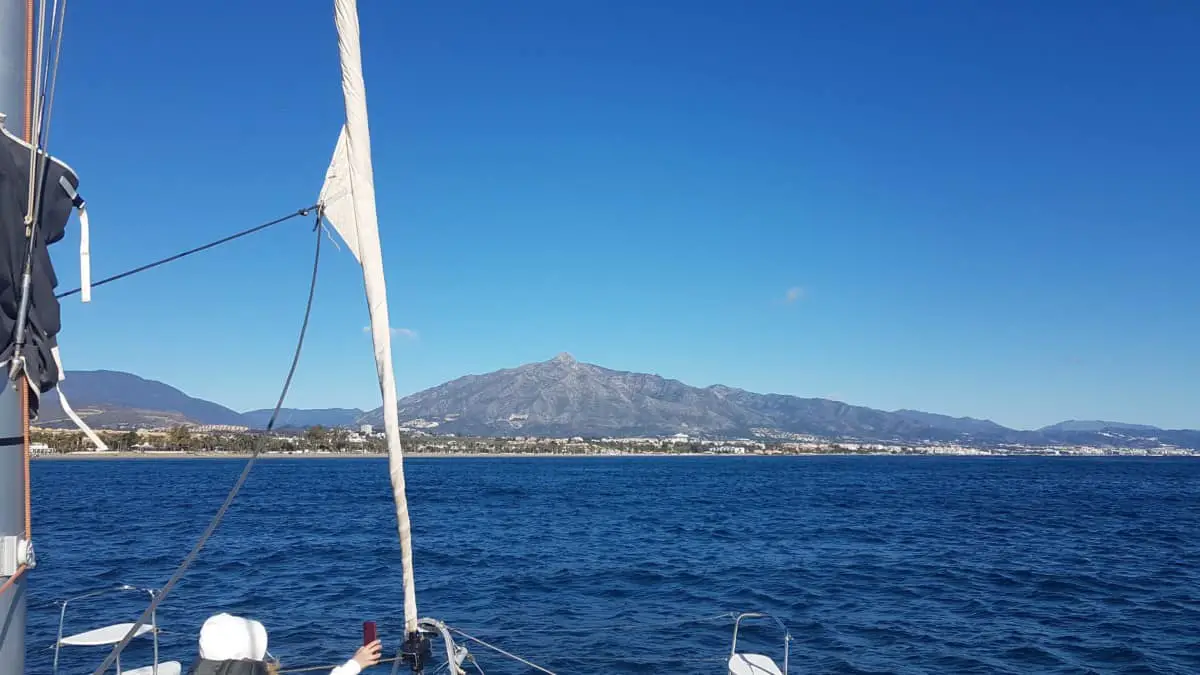
As an Amazon Associate, we earn from qualifying purchases. We may also earn commissions if you purchase products from other retailers after clicking on a link from our site.
When I transitioned to a life of seaborne travel and adventure, it came with several challenges, the first being deciding the type of boat to use. In that process, I came across terms like “blue water sailing” and “catamaran.” A few years later, I think I got the hang of it, and today I want to share my knowledge on what exactly a blue water catamaran is!
A bluewater catamaran is a multi-hulled vessel used for extended voyaging that can sail in very rough seas. Offshore catamarans are usually 40ft or longer, very stable, carry heavy loads, and are designed to be very safe.
Some say blue water catamarans make sailing under the most demanding conditions comfortable and safe, but are they right? Read on for detailed explanations of the features that make this boat type an excellent choice for sailors.
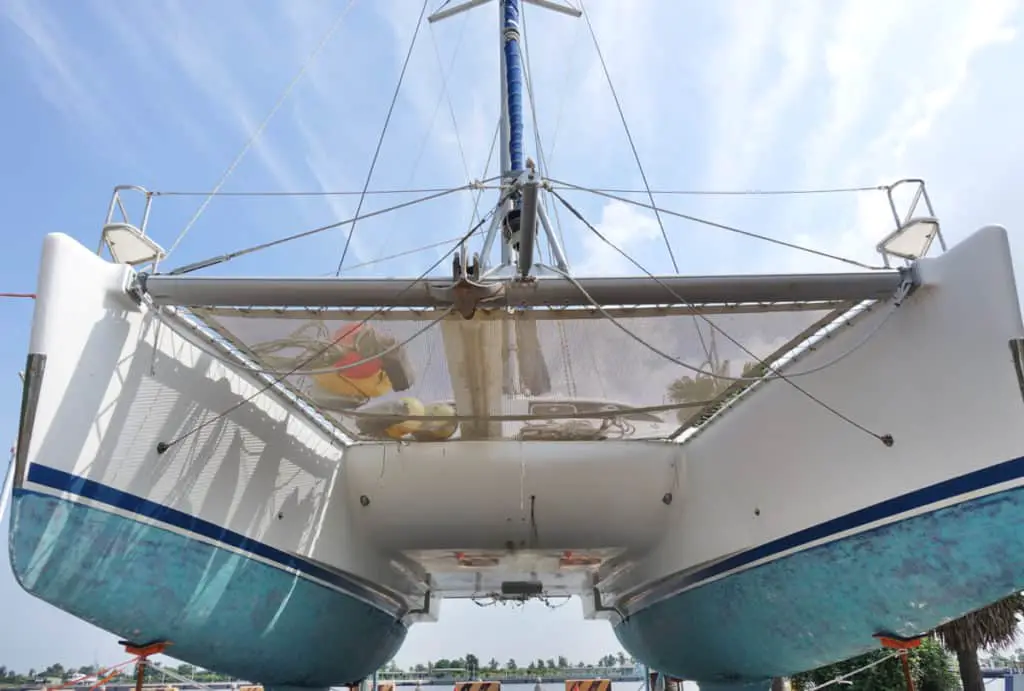
Table of Contents
What Is a Catamaran?
A catamaran is a sea vessel constructed from two hulls that lie perpendicular to each other. This type of boat is traditionally used for recreational purposes. However, it is also quite common to use them in the commercial fishing industry.
If you want an in-depth explanation i suggest you read this article.
They are fitted with both sails and a combustion engine, these can run together or separately.
Usually, these vessels will have at least one headsail (generally referred to as a staysail), and one mainsail.

What Is a Blue Water Catamaran?
Bluewater catamarans are generally larger than boats made for coastal sailing. On average, these vessels come in sizes between 30 – 70 ft, offering cargo and passenger space for a few dozen people or more. They feature carbon fiber or fiberglass construction and come in different sizes for various activities. Some of these blue water boats feature flybridges.
What is a flybridge?
A blue water boat is a boat that is optimized for sailing big oceans and doing long ocean passages. This is to be compared to a coastal cruiser which mainly is used for sailing less rough waters and where the need for storage to hold multiday provisions isn’t necessary. A bluewater catamaran is also equipped with more advanced technology and offers better protection from the weather. More on this further down in the article.
Why Are They Called Blue Water Cats?
Blue water sailing is a term that refers to the open ocean. Non-blue water sailing, on the other hand, typically means navigating inland waterways and coastal areas.
The difference between blue and non-blue waters lies within their visibility as well as hazards present in each location. The two types of seas have different types of challenges for sailors, especially when it comes to navigation at night or if you have a storm brewing on the horizon.
Blue water sailing is primarily done on the open seas where there is a lot of room to maneuver and travel long distances without hitting land or running into shallow waters. These types of voyages take place during the day, as well as at night when necessary. As a result, blue water sailing requires more gear, skills, and sturdier vessels.
Non-blue water sailing typically does not venture out too far from shore and stays within sight of land so that it is possible to find a way back home if need be.
Generally, blue water boats are more powerful (bigger sails and engines), while non-blue water vessels may not need to move at higher speeds, so they feature smaller sails and engines with lower horsepower.
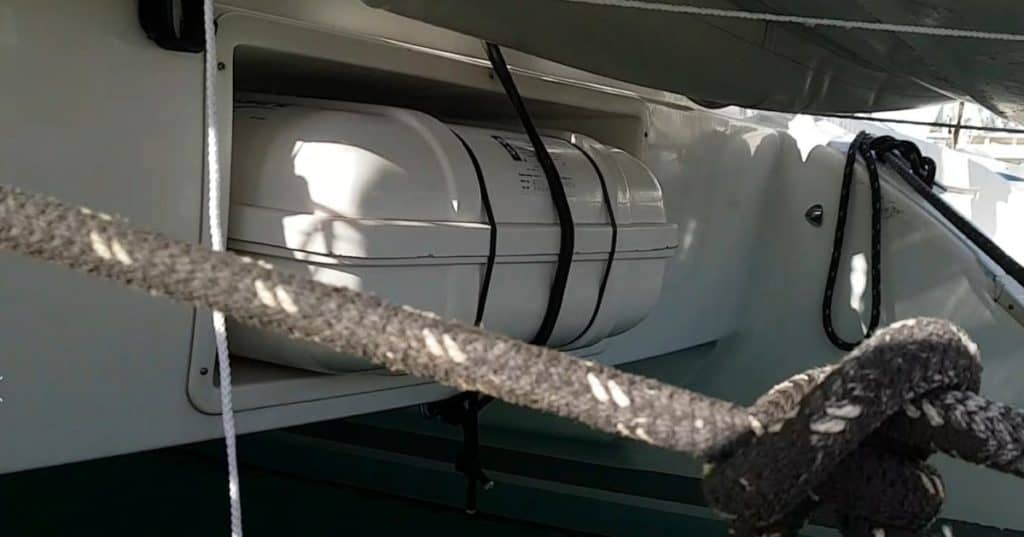
How Is a Blue Water Catamaran Equipped?
A blue water catamaran comes with all the equipment necessary to make your voyage on open water safe and as comfortable as can be.
Here are some of the standard features you’ll find in this boat type:
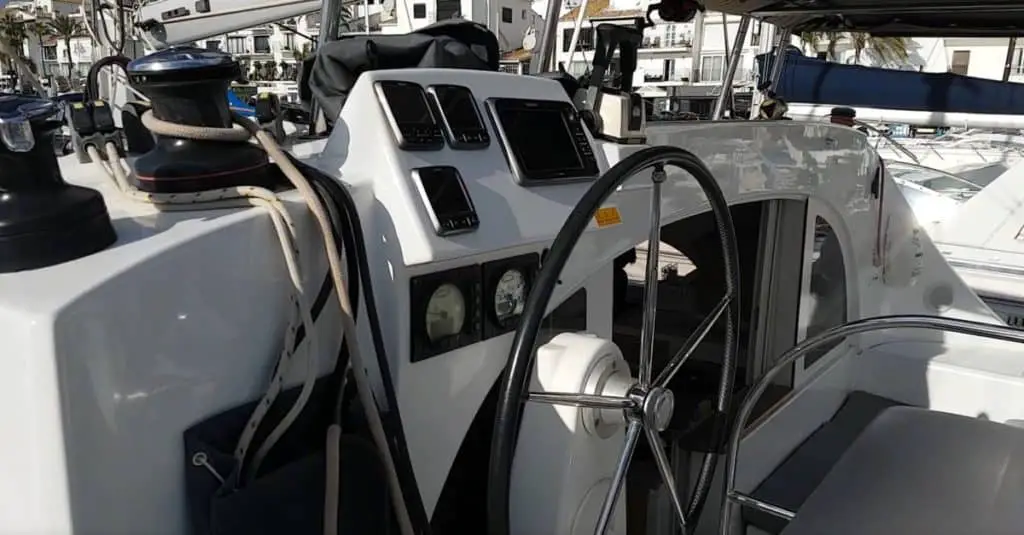
The autopilot is a critical component of a blue water boat. Cruising without it can arguably be an absolute nightmare. You’d be precisely glued to the helm the entire journey, making it burdensome and uncomfortable. These boats come with in-board pilots whose rams are fixed directly to their rudder segments.
This is not a “nice” to have feature; it is definitely a “need,” Without it, you will tire out the crew and significantly increase the risk of sailor error.
The best catamarans feature durable, easy-to-adjust, and effective pilots that can easily take you on a voyage without breaking down.
Pro tip: carry one extra, sooner or later it will break!
Global Positioning System (GPS)
The GPS is undoubtedly essential equipment on any cruising vessel. Blue water boats come with either bottom of the range GPS, which gives you the exact position, or top of the range GPS, linked with electronic cartography.
Electronic cartography allows you to view charts for the whole world, the boat’s position, speed, waypoints, ETA, water depth — to mention but a few — resulting in a much more effortless navigation. For instance, you can use it to avoid rocks when sailing along a coast.
There are many options but usually it is the budget that sets the standard.
A Good Dinghy
A good dinghy is a must-have in a catamaran. You use it to go ashore, bring provisions into the boat, refill water, go diving, or lay an anchor to complete your mooring – it’s a versatile piece of equipment that makes cruising easier.
It can be placed at the stern, or under the davits, between the hulls to allow for flexibility and easy access to hard-to-reach places, such as coral beaches.
Remember! A dinghy is not a life raft, they are designed for different things!
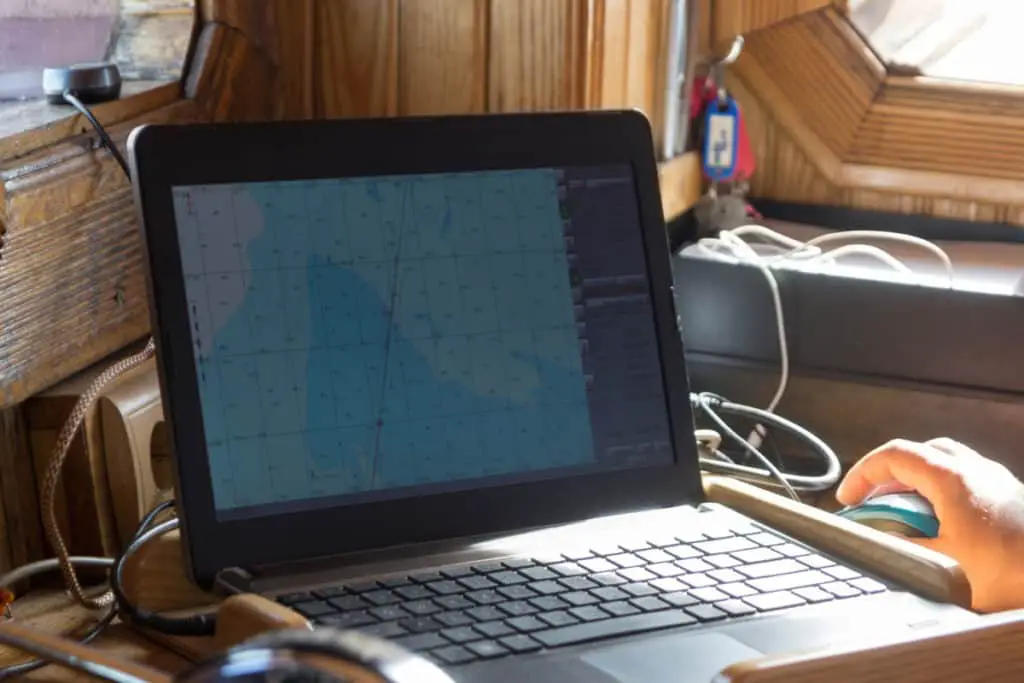

Computer/Navstation
Modern cats come with computers for comfort, convenience, and safety. These devices are used for electronic cartography, receiving weather data, and as support for the logbook.
You can use them to process digital photos and send or receive emails – you can still keep in touch with clients and friends as you enjoy the therapeutic sea. Besides, you can store music and watch movies during the journey – the applications are endless!
A marine radar scanner is a critical offshore device and a must-have on a blue water catamaran. It’s used to detect obstacles, other sea vessels, to mention but a few. It produces radio waves, which travel around the water surrounding the boat up to the horizon. It then detects if the waves have been reflected, showing you whether there’s an object on your course. This information is essential since you need it to avoid a collision.
It will also show you where the closest squall is and what direction it is headin giving you enough time to reef your sails.
Power Source
A catamaran’s engine and appliances must be supplied with energy – a no-brainer. A cat generally comes with two starter batteries: one for each engine and one or two more for its equipment. These batteries are charged by the engines. However, you must run the engine for several hours daily to keep them charged.
Instead of that, most sailors use solar panels or wind generators. A technology that is becoming more and more common is using the propeller to generate energy.
Many cruisers also have a standalone generator for charging batteries and supplying power to on board electronics.
What To Look For in a Blue Water Catamaran
When buying a cat, it’s critical to identify the one that best suits your needs. Regardless of whether you plan to use it for fishing, racing, or voyaging, here are some of the critical factors you should consider:
The key considerations here should be strength and durability. Fiberglass is generally the main material type used in hull construction. Fiberglass is the most preferred since it’s strong and durable. The difference lies in the hull core, usually the core is either some organic material such as balsa, or it could be a synthetic such as plastic foam.
The balsa is cheap, but if there is a water intrusion, it will start to rot, and structural integrity may suffer. The foam sandwich type is usually unaffected by water intrusion but tends to be more expensive.
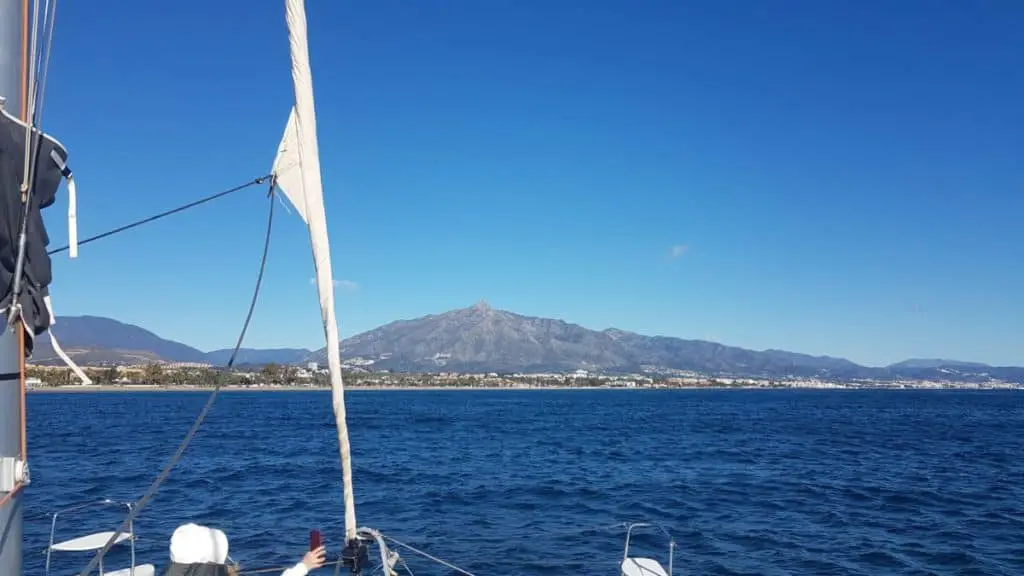
The Sailplane
It would be better to pick a catamaran with an easy-to-handle sailplane. The primary issue here is manageability – the staysail should be easy to replace using a hanked-on storm jib during stormy weather. Also, even though you have a crew on board, the sails should be set up for shorthanded sailing, so the helmsman doesn’t have to wake up the crew every time adjustments need to be made.
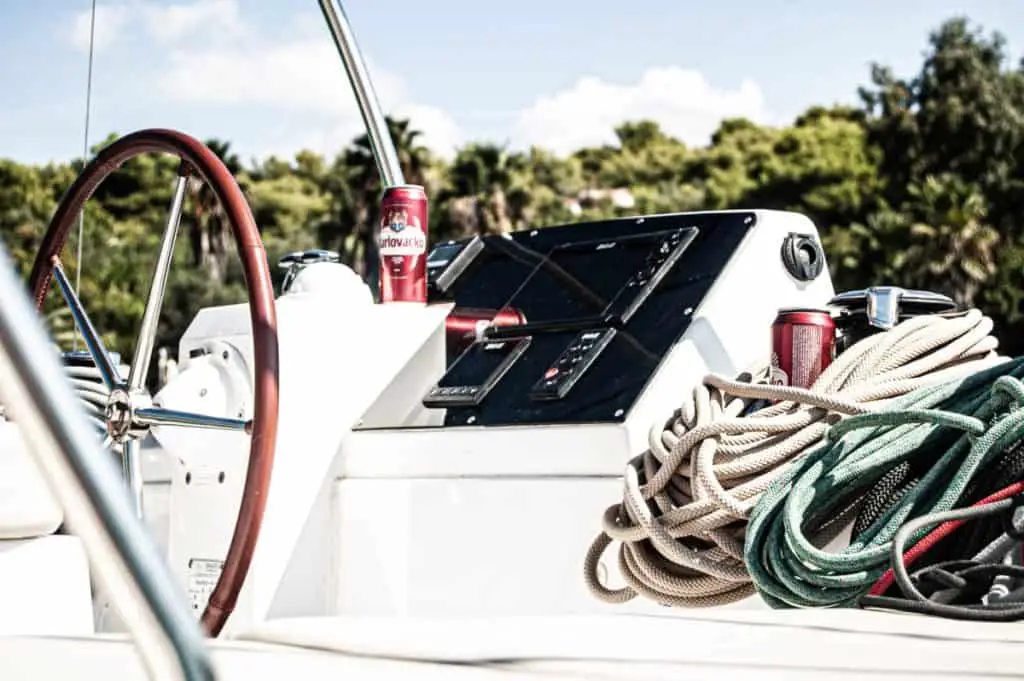
The cockpit should be a priority consideration when choosing a catamaran for offshore adventure.
Aft cockpits are generally better than center since they’re lower and better protected, making them safer. Besides, an aft and centered cockpit suffer less impact from boat motion.
Flybridge helms are great looking and awesome for coastal sailing, but for safe offshore passages, they offer many safety issues that, if you want to, can read all about in another one of my articles .
Heavy or Light Displacement
The opinions of sailors on the displacement type vary based on the tradeoffs of either option. On the one hand, a heavy displacement hull with long overhangs and a full keel provides a more comfortable ride in rougher conditions but performs poorly in lighter conditions.
On the other hand, light displacement is limited in stowage. Most notably, too much load affects its displacement ratio, compromising performance. However, it comes in handy when you need to manage heavy going.
When talking about catamarans one should mention that “heavy displacement on a cat” is not the same as “heavy displacement on a monohull”. The cat will still be very light in comparison to the monohull, but when comparing a catamaran with another catamaran “heavy” vs “light” makes sense.
Water Supply
During your journey, you’ll definitely need sufficient fresh water for washing, cooking, and drinking. Because of that, you should look for the water storage capacity of your sailboat.
As a rule of thumb, you should look for a cat with sufficient water storage for your crew, plus a 20% allowance. To put it into context, a couple on a transatlantic passage would need two imperial gallons daily, plus a 20% contingency allowance.
Suppose the couple goes on a three-week adventure. In that case, they’ll need a minimum of 50 gallons of fresh water. Blue water cats ideally have double that capacity, usually split into two tanks. If one gets contaminated, they can use the second one.
Tip: It’s prudent to rig a system that catches rainwater when the boat is underway or anchored. You can also use a reverse osmosis watermaker. However, it shouldn’t be the sole source of water. These watermakers can break down, causing a lot of inconveniences.
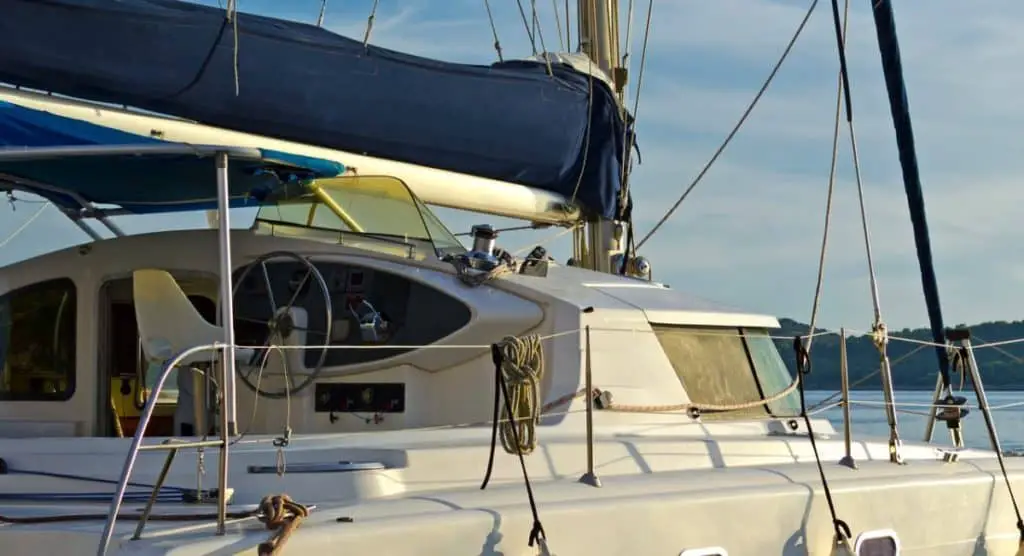
Protection From the Elements
However much you may wish to cruise in sunny, calm, dry weather to have an uninterrupted view of marine life during your journey, chances are you’ll encounter some rain, wind, or flying spray. Therefore, it’s better to pick a catamaran that comes with a well-protected helm to shelter you and your crew from the elements. Depending on your preference, the dodger can be a canvas construction around a collapsible frame or a rigid structure.
Too much sun can also cause discomfort and damage your skin, so you should ensure the sailboat comes with a bimini top cover.
What Are the Best Blue Water Catamarans?
There are so many awesome blue water catamarans I could make an entire website about them, but here I have listed two interesting examples that could act as a jumping-off point to your future research.
The Lagoon 55 is a luxurious cat designed by Marc Van Peteghem , a renowned French Naval architect. This boat is spacious – it can be arranged with up to six double cabins and comes with a more extensive flybridge. Its transom’s surfaces aren’t just a way to access this vessel; they can be converted to a living area. This boat also comes with a dedicated forward cockpit connected to the saloon by a drop-down window.
Fountaine Pajot Elba 45
The Elba 45 is an incredible catamaran. Designed to replace the Helia 44, this boat has done the job perfectly. It comes with high-speed, efficient motoring, and remarkable performance. Its fixed stub keels and aft-raked bows deliver top-notch windward performance.
To improve safety, this sailboat’s keels are glued into a designed recess in the hulls. Because of that, none of the keel bolts can rip out and put you in danger in the event the Elba 45 gets grounded or collides with an obstacle.
Besides, this boat features a low-profile lounging space, a pronounced reverse sheer that minimizes the bulk of windows to create useful space below, and high topsides and bows.
If these are out of your range or not interesting I suggest you check out some of my other articles:
- Best catamarans under $200k
- Best catamarans under $100k
- Best catamarans under 50ft
- Best catamarans under 30ft
- Best catamarans for couples
- Best catamarans sailing around the world
Frequently Asked Questions On Blue Water Cats
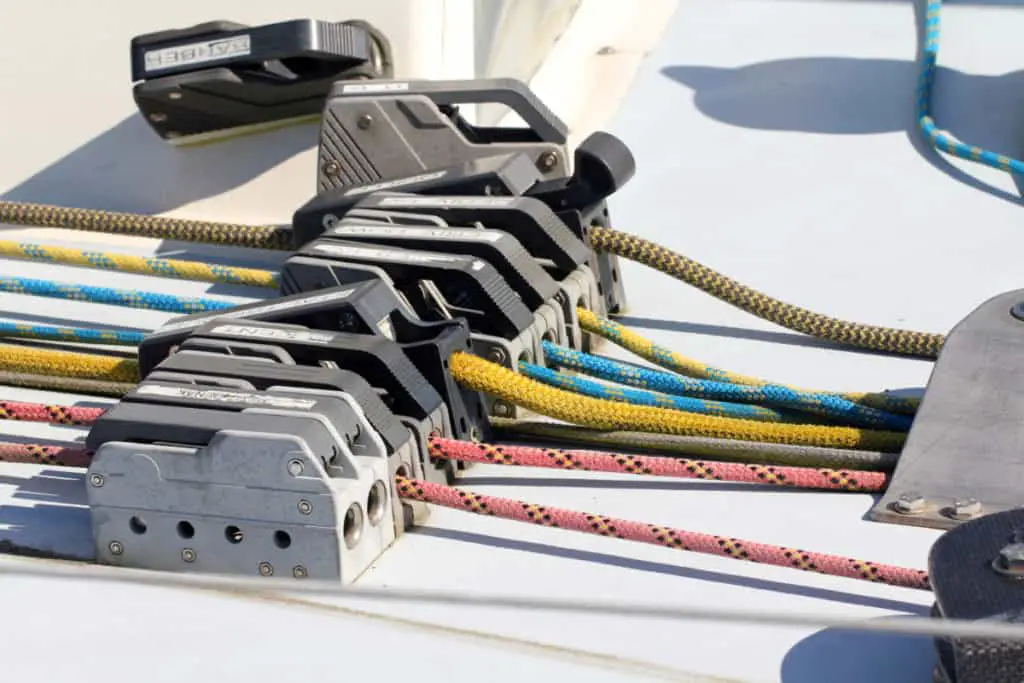
Can One Person Solo a Blue Water Catamaran?
Blue water cats (and cats in general) can be sailed shorthanded if they are set up correctly, this setup includes all lines to the cockpit, roller furling mainsail, and autopilot. The skill of the sailor is also essential for safe single-handed sailing.
Tip: Take extra precautions when sailing offshore such as adding an emergency position indicating radio beacon (EPIRB) or including additional radar reflectors on board.
Also, before sailing a blue water cat, check the relevant state and federal regulations. For instance, most states require sailors to complete safety courses before sailing, while others require you to obtain a license.
I have a dream of solo sailing my cat around the world, if you want to know how this can be done I suggest you read some of my other articles:
- Can one person sail a catamaran?
- Best solo blue water catamarans
- How to single-handed sail a cat
Can I Cross Oceans Using a Blue Water Catamaran?
Crossing an ocean with a blue water catamaran is one of the safest ways to do it! This is due to their excellent stability, safety, and crew space on board. They are inherently more stable than any other type of boat due to their exceptional buoyancy and roll inertia from their unique hull design.
This means that these catamarans will seldom capsize in extreme conditions but give good protection against the weather or damage caused by strong wind gusts. They also have less side motion, so even though waves may break over the deck during bad weather, there’s no risk of people sliding off, creating a man-over-board situation.
What Is a Good Size Catamaran For Crossing Oceans?
The perfect sized catamaran for sailing big oceans is around 40ft; it is small enough to be sailed by one person but big enough to provide safety and speed. Of course, there are many variables to consider.
Want to know more? Read Best sized Catamaran for Ocean Sailing and Liveaboard
Wrapping Up
Indeed, a blue water catamaran is the best companion for anyone going on a long adventure on the sea. Its fiberglass construction, twin hulls, expansive deck and interior space, and natural redundancy design makes for a safe advenure.
I hope this was useful, take care and live the adventure!
Owner of CatamaranFreedom.com. A minimalist that has lived in a caravan in Sweden, 35ft Monohull in the Bahamas, and right now in his self-built Van. He just started the next adventure, to circumnavigate the world on a Catamaran!
Leave a Reply Cancel reply
Your email address will not be published. Required fields are marked *
Save my name and email in this browser for the next time I comment.
Recent Posts
Must-Have Boat Gear for Catamaran Sailors!
Sailing is probably the most gear-intensive activity I've ever done; there are so many decisions to be made about what gear to buy now, for tomorrow, and what to definitely never buy. The gear on...
6 Best Trailerable Trimarans For Bluewater and Coastal Sailing
Having a boat costs a lot of money, even when you are not using it, marina fees, etc. And once it is in the water most sailors never go very far from their "home marina" and sailing will be somewhat...

Berthon Winter Collection

Latest issue

August 2024
In the August 2024 issue of Yachting World magazine: News Few finish a tempestuous Round The Island Race European rules are eased for cruising to France and Greece Olympic sailing…

Yachting World
- Digital Edition

Catamaran cruising: everything you really need to know
- Nikki Henderson
- September 21, 2022
Expert skipper Nikki Henderson reveals what you really need to know before going bluewater catamaran cruising

It has become routine now for me to bookend the summer sailing season with a trip to the south of France for the biannual ‘Outremer Week’. This hugely popular event gathers 100-plus new Outremer catamaran owners for five days of training, both in the classroom and on the water, and three days of friendly racing. The goal is to educate future owners so they are as prepared as they possibly can be for their upcoming bluewater catamaran cruising plans.
It’s an intensive week of 12-hour days, with a lot of information to absorb. Unsurprisingly there are some discussions specific to bluewater catamaran cruising that come up repeatedly, and they apply to owners or prospective owners of all brands of bluewater multihull. Here are some of the most common questions people ask me:
What sails should I buy for a cruising catamaran?
Every day after sailing a new catamaran owner will come up to me and say, “Nikki, I’d love to take up some of your time and rack your brains about sail selection .”
To pitch my advice appropriately, I always ask some key questions about your catamaran cruising plans, and I’d encourage you to ask yourself the same.
What is your route plan?
Tradewind sailing will be predominantly downwind. So, focus your attention on downwind sails. A route involving more upwind requires more focus on headsails. Routes involving more upwind tend to be more coastal routes, or schedules with strict timings that will reduce the option to wait for downwind weather windows.
All bluewater sail plans will need storm options. Three reef points in the main is a must, or at the very least an extremely generous second reef. A storm headsail is another key component. Ideally it should be possible to hoist the storm jib up over the top of your furled foresail. In very big conditions, reliance on the thin furling line gets quite nerve-racking.

Catamaran cruising sail options range from symmetric spinnakers to Code sails for reaching performance. Photo: Nicolas Claris
How performance-orientated are you?
Performance catamarans are designed to sail angles downwind, ideally with an asymmetric spinnaker wardrobe. However, there is a cost to the incredible speeds that you can attain reaching on these boats: comfort. So, a key question is what is your attitude to speed versus comfort?
Performance-focused sailors are typically racing sailors, sailors without kids, or sailors who are in good physical shape. If you fit this category, then I’d advise purchasing one heavy weather flat-cut asymmetric sail that can withstand a squall up to 40 knots, and a rounder, lightweight sail that you can sail quite deeply in light to moderate conditions.
If you don’t have a taste or attention span for speed, then one heavy weather symmetric spinnaker (approximately up to 40 knots TWS) should be enough. This will allow you to sail a rhumbline course, and make night-time take-downs less of a worry because the kite will survive a squall.
For upwind, if you will enjoy fine tuning your boat to get that extra half a knot, your ideal option is a large genoa for drive in light to moderate conditions, and a small flat blade-shaped jib for heavier conditions – small enough that it does not need to be furled to an inch of its life to cope with a Force 6. If an inner forestay is an option, the latter could be a staysail which will keep the centre of effort low and reduce sideways drift.
For anyone less performance orientated in their catamaran cruising, the key for upwind sailing is a strong, flat jib that is not too big. Mark three reef points on the foot with sail tape. Keep an eye on how much it stretches and don’t be surprised if you need to change it every few years to avoid losing 5-10° of height.
Downwind the tradewind route logic applies: performance sailors should invest in asymmetric and non-performance sailors in symmetric spinnakers.

Left: taking videos and photos to remember key points of spinnaker handling technique. Photo: Robin Christol/Outremer
Who’s the crew?
At this point, the conversation often goes full circle. Sailors get enthusiastic about performance, and then remember that the kids will need home schooling, or that this is a retirement plan with potential health and fitness considerations.
Most sail changes will require more than one person, and conditions at the bow can be bouncy. Crew also have to be able to sleep, cook, and live on the boat while it is thrown about. If you are short-handed, you could compromise for downwind sailing by choosing furling sails.
A furling asymmetric such as a Code D can replace the ‘hoist and drop’ asymmetric. Or you can make the sock line on a symmetric long enough to route back to an electric winch.
Upwind sailors could compromise by returning to a single jib and consider altering routing to sail slightly off the wind but faster; optimising for VMG. If you have a staysail, ensure it could be furled and therefore left rigged at sea – though make time to speak to the yacht designer about the impact on stability that having two heavy furled sails up continuously could have on the boat.
How ‘eco’ and time-conscious will you be?
Do you care about motoring? Increasingly for many of us, awareness of climate change is a strong motivator to avoid using the engine. And will you be more focused on the destination or more interested in the journey?
If you are keen to avoid motoring, and you are free of time constraints such as fixed crew changeovers or grumpy children who need to stop and swim, then I’d recommend you invest in a Code 0. A Code 0 can double or even triple the boat speed: in 6 knots of wind, an Outremer will sail at 2-3 knots with a jib, but 5-6 knots with a Code 0. It’s a great sail and worth the investment, but first work out if you will use it. They often have low wind limits – around 15 AWS – which upwind could be 10 knots TWS.
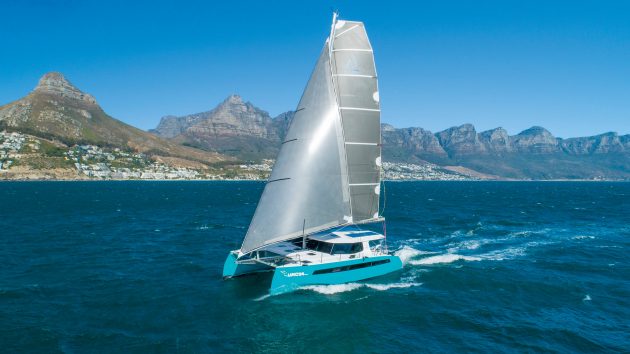
Code sails for reaching performance. Photo: Balance Catamarans
When do you reef a catamaran?
Many bluewater cruisers will reef down before dark every night. I’m not a huge fan of this as a rule; reefing should be straightforward enough to not be an intimidating manoeuvre in the dark.
But all new catamaran owners who are planning to go bluewater cruising are concerned about knowing when to reef, especially if they come from monohull sailing, as a catamaran communicates whether it is overpowered or not in a much more subtle way.
You want to conserve your equipment while sailing the boat effectively. So aim for the least amount of sail necessary to achieve your target speeds and angles. The best way to get to know this is to put reefs earlier or later each time and take note of whether it was beneficial or not. Over time you will know your boat very well.
Sailing favours guidelines over hard rules, but it’s good to have a starting point so here are some general ranges. For more cautious sailors or bigger sea states, use the more conservative side of the wind range:
- Reef 1 in at 15-20 knots TWS
- Reef 2 in at 20-25 knots TWS
- Reef 3 in at 25-30 knots TWS
Note that I am using true wind and not apparent. When sailing downwind it’s tempting to fly more sail because the apparent wind is so low. However, if you need to turn upwind – perhaps to reef – the 12 knots AWS in 20 knots TWS will quickly become closer to 25 knots AWS.
Reliance on numbers is great until the wind instruments stop working (it will happen at some point). Remember your RYA Competent Crew course and use the descriptions of the sea surface at various Beaufort Scale forces to identify how windy it is.

How to share roles is a frequent question among couples planning a catamaran cruising adventure. Photo: Robin Christol/Outremer
There are other telltale signs that the boat gives if she needs a reef. Although hulls don’t fly unless you are at the performance level of a Gunboat or similar, you may feel the windward hull just slightly lifting. This is a sign that a reef might be needed. Another is if the bows are diving down when you are sailing downwind. Heel angle can be most obviously sensed while lying down.
The main hindrance to learning when to reef – and when not – is a hesitation to perform the manoeuvre. If taking a reef feels arduous, people avoid it. I admit I can find myself in this camp: I have to remind myself that it’s a win/win, either it’s the right decision and the boat sails better, or it’s wrong and I’ve learnt from it.
The key to reefing is to practice. Taking a reef should be possible to do in under two minutes, especially if you have fast electric winches.
It’s handy to have the option to reef downwind, especially if you’re tradewind sailing. Fully battened mainsails struggle to come down so set up downhaul lines from each reef tack point. Run them through the reefing point on the sail and through the reefing points on each side of the mast so the sail is pulled down in line with the track. Watch out for chafe on the back of the main if reefing a lot downwind, and add spreader patches to your sail where applicable. Centring the traveller during the manoeuvre can help, but keep your eyes looking up and check nothing is getting caught.
Also practice solo reefing ; aside from the possibility of needing to reef alone, this also builds a big picture understanding of the whole manoeuvre. It means reefs are put in faster because anyone can work anywhere.

Catamaran designs at the ARC start cover a full spectrum of performance. Photo: James Mitchell/WCC
How can couples close the ‘experience gap’?
The argument for both halves of a cruising partnership being competent on board has always been that if something happens to the skipper, their partner will know how to safely get to a port of refuge.
However, most people assume that this will simply never happen to them, or they practise parking a couple of times, pick a fender out the water – then never think about it again. The difficulty with starting a bluewater sailing project with a large experience gap is that it tends to widen over time. Each day as leader will be a learning opportunity for the skipper.
They will grow in competence and confidence. Meanwhile, the first mate’s skills will suffer. They will get used to following instructions, their confidence will decrease, and a habit of helplessness will develop. Then, when an emergency does occur, they’ll be in a worse position to take charge than when they started.
It’s critical that couples approach buying a bluewater catamaran for cruising as a team exercise from day one – for both safety and enjoyment. Ideas on how to level up your partnership include:
- Rotate roles each day, or follow a rota. Who drives the boat into dock? Who makes the navigation calls (do this passage by passage)? Who does the safety checks? Who runs the watermaker?
- Divide the boat – maintain one hull each and share the saloon. This forces you to both understand how everything works from bilge pumps and engines to steering gear and gear storage.
- Take a coach with you for the first few crossings. It can be hard to learn to sail from your spouse. A professional coach will force you into a learning environment. They will also create space for the less experienced to be able to take charge in a safe way.
- Sail the boat without your partner. Creating a scenario where your leadership role feels natural is the optimum way to practice skippering. So, invite a few friends who don’t know as much about sailing as you, and go for a low pressure cruise. It’s a brilliant confidence builder, and a chance to develop your own style and your own voice on board.

Do you have the skills for a faster cat? Photo: Rick Tomlinson
Production or performance cruising catamaran?
A common view is that you pay more for less when you buy a performance catamaran: fewer creature comforts, less living space, fewer berths, bathrooms, and instead get narrow hulls and sparse design. So, is the big price tag worth the upgrade in performance?
If you are lured by the comfort of a production catamaran, but plan to sail intensively around the world for the next five years, it might not actually be the most comfortable option. No dishwasher or air conditioning is going to make a boat feel safer in a storm. Conversely, why buy a performance catamaran if you plan to leave the boat at the dock for 10 months a year?
Ask yourself if you have the skills to harness the performance of a faster catamaran? And if not, how prepared are you to invest time into learning how to use the boat to her full potential?
A common justification for buying a performance catamaran is that it can outrun bad weather and therefore is safer. But you cannot take advantage of that option if you sail everywhere with three reefs in the main because you are nervous of the boat’s power.
Similarly, the power of performance catamarans comes in part from how light they are. If you load the boat with extras – personal gear, kitchen appliances, heating, aircon – you will quickly reduce a lot of the speed and safety advantages you’re paying for.
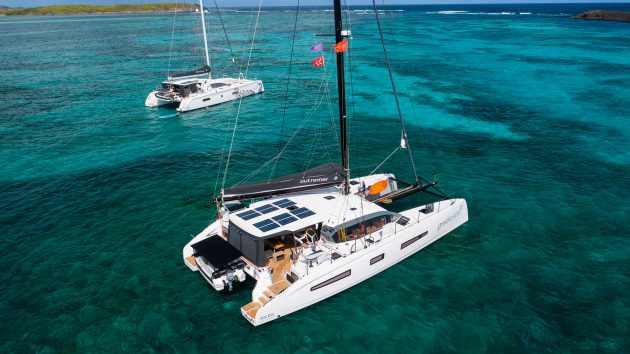
The dream – catamaran cruising in paradise! Photo: Robin Christol/Outremer
How to handle heavy weather in a cat?
A popular heavy weather strategy is avoidance: account for global weather patterns when planning your passages to ensure you sail during the more favourable months; invest in a good satellite connection to download accurate forecasts so you can see bad weather coming; use your boat speed to position yourself out of the predicted storm track; be flexible with departure windows and leave at an optimum time.
However, do not misinterpret avoidance of heavy weather as a safety net. With weather systems becoming increasingly extreme and unpredictable (see page 38), this risk management strategy is becoming less and less dependable.
- Develop scenario plans for the type of boat you have so that you don’t have to start with a blank sheet of paper as a storm approaches.
- In all scenarios, on all boats, avoid 90° wind and waves. Your boat is at its least stable in these conditions. Sail with the weather forward or aft of the beam.
- Keep an eye on heel angle. Reduce sail if you start to see any more than 5° or so, unless you have a catamaran that is designed to lift a hull. Lower the centre of effort by reducing sail, starting with the main.
- Set up and practice how to reef downwind in case the weather comes in more quickly than you were expecting.
- If you can’t sail as fast as the waves, consider trailing warps to slow you down and help with steerage. You should aim to keep the speed relatively high. The key is to reduce the erratic surfing which drops the bows into green-water troughs. I prefer warps to drogues where possible because we are more familiar with them. Unless you practice using a drogue regularly, you will likely need to read the instructions when you get it out, which isn’t ideal in an emergency.
- If waves are breaking over your stern, consider turning into the seaway and holding steady. In a performance cat, you can drop the windward daggerboard, lift the leeward board, and pinch into the wind. In a production cat with no daggerboards, this will be difficult. Running the leeward engine might help you keep your bows into the wind. Watch that there is no back flow of water into the exhaust.
- Avoid lee shores at all costs, sea room downwind is key.

Outremer Week crews receiving coaching on sail handling. Photo: Robin Christol/Outremer
When should we go?
How long should you wait after buying a boat before heading out on your first bluewater passage? Whether you spend £100,000 or £1,000,000 on your boat, it’s likely to need some fine tuning. I’ve never heard of a new boat that was perfect.
Some yards will cover the initial issues as part of the warranty, so staying close to the yard is a good idea within that period. Even if you don’t have a warranty, proximity to the yard can help you access parts, boat builders and people who understand how your boat has been constructed.
The flip side is that you want to get going, and experience all the freedoms of your new yacht! Some serious bluewater sailing is also needed to test some of the systems.
Give yourself two to six months before you head out on the first crossing. This is enough to test the boat out, but not so long that ‘passage-anxiety’ builds up and you never actually leave.
Do not treat the first few months as a holiday. This is commissioning, and it is the last stage of the build. Test the boat as rigorously as you can before you leave the proximity of the yard. Complete a couple of substantial offshore passages of 48 hours or more to test the systems. Run everything, including the watermaker. Fly all the sails you own. Sail in fruity conditions relative to your ability (Force 6-8 as a guideline) to see how the boat (and you) cope.
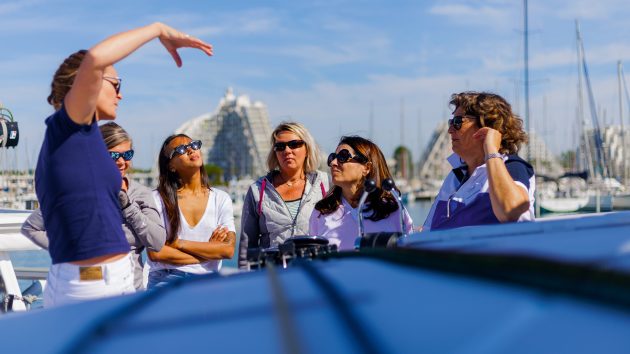
Women’s only coaching groups for catamaran cruising sailors help bridge the ‘experience gap’. Photo: Robin Christol/Outremer
Get some experienced people on board to bolster the crew for the early days. The ideal is to hire a professional coach, as this will make pushing the boat much safer and more fun for you.
Do some training ; the MCA AEC four-day engine course is a really useful opportunity to explore the parts of the engine you are normally too nervous to. A safety at sea course is worth its weight in gold. Use this to put together a safety kit that you feel confident in and that is appropriate for your cruising plans. A basic maintenance course can also be helpful, ideally one that covers beginners’ sail repair, rigging, splicing, and electrics.
Ask other sailors for a good tools and spares inventory list. On top of the standard parts that the equipment manuals recommend, current and previous owners of your boat model will have a plethora of advice.
Confident to cast off
Preparation for any type of bluewater sailing can feel daunting. Training courses and cruisers’ seminars like Outremer Week are a little paradoxical – learning how to insert an IV line in a morning medical session, then toasting your upcoming lifelong dream in the evening. It’s a bit like watching the flight safety demonstration before taking off on a once in a lifetime holiday.
The reality is that bluewater sailing is the most incredible opportunity in the world to be both savoured, and treated with an appropriate level of respect. But the most rewarding thing is to see sailors’s enthusiasm grow as they learn. With the opportunity to make mistakes and ask questions in a supportive environment, everyone develops their own skippering style and mantras.
Knowledge nurtures confidence, and confidence breeds positivity – which all contribute to a safe, and successful bluewater catamaran cruising experience. If in doubt, ask!
If you enjoyed this….
Yachting World is the world’s leading magazine for bluewater cruisers and offshore sailors. Every month we have inspirational adventures and practical features to help you realise your sailing dreams. Build your knowledge with a subscription delivered to your door. See our latest offers and save at least 30% off the cover price.

Longreach 1200 – 600HP
Longreach 1400 – 460Hp & 500Hp
Longreach 1400 Hi-Performance
Longreach 1900 Expedition
Longreach 1900 Bluewater

About the LR Bluewater
The Longreach Bluewater is a brilliant balance between the comforts required for full time live aboard cruising, with efficiency in hull design for low fuel consumption and long range exploration. Reach further, stay longer.

Statistics Can Go Here – Statistics Can Go Here — Statistics Can Go Here – Statistics Can Go Here –
The Longreach Bluewater hull features a reverse bow to extend the waterline out as far as possible to maximise efficiency, while also providing a wave piercing effect for a smooth ride at speed. The chines at the waterline ensure a dry boat, while under the waterline the hull features two docking keels to enable safe beaching while also protecting the running gear. The hull is a full displacement hull but designed to motor at cruise speeds of 12 knots, or top speeds of around 25 knots. The 58 comes standard with long range tanks totalling up to 5,600 litres of diesel providing more than 2,000 miles range at 11.5 knots and a top speed of 20 knots.
Helm & Flybridge
The flybridge is super social, with a massive lounging area, dining table, wet bar with fridge / freezer included. It has a panoramic view will can be completely enclosed with high quality clears, or if you prefer, glass windows.
While the helm has twin seats with full support, a full suite of electronics at your fingertips and the wheel and throttle controls from the centre allowing you to stand when berthing. Either side of the helm seats are more lounging seats – people will just gravitate to these areas, plus forward steps to the front deck for easy access to the bow.
Statistics Can Go Here
Saloon, GALLEY & Cockpit
Interior cabins, walkthrough with owners.
We join Longreach Director Andrew Mcleod with owners Peter and Penny as they take to the islands around Pattaya, Thailand on board their brand new Longreach 1900 Bluewater power catamaran!
Certificate CE Class A with Lloyds Scantlings
Vessel layout.
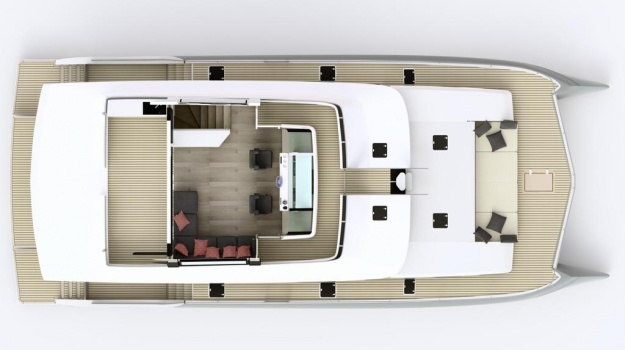
Complete for an info pack or request a guided walk through tour.
" * " indicates required fields

- Who is longreach
- LR1200 500HP
- LR1400 460HP & 500HP
- LR1400 HI-Performance
- Request an Information Pack


Don't miss another video. Subscribe to our YouTube Channel

Introducing the New Privilege 650
The wait is over. Introducing the New Privilege Signature 650 blu, the Forever Catamaran. We just posted new exterior photos of blu sailing in Les Sables d’Olonne this past month. More to come!

There’s A Storm Waiting for You
Every experienced sailor knows that no matter how well you plan your passage, chances are good that you’re going to encounter some severe weather out there.

Forever Catamaran | The New Privilege 650
We like to say that good ideas are permanent. The Privilege 650 is a reflection of the true nature of Privilege catamarans. See highlights aboard the first 650

INTRODUCING THE NEW SIGNATURE 650
The New Signature 650 is an evolution of the Series 640 and builds on the same proven offshore hull design. The collaboration between Franck Darnet and Marc Lombard combines sailing performance with living comfort.
TOUR THE INTERIOR OF THE SIGNATURE 650
The interior layout aboard the new Series 640 Segundo Viento is built with the same concept as the new Signature 650. From full formal dining to casual lounging for movie night, the adjustable salon layout can be configured to suit all your living requirements.
The Home of Privilège
Privilège 510, privilège 580, privilège 650, privilège 750, stay connected +1 613-981-1740.
- Outremer 45
- Outremer 4X
- Outremer 4.zero
- Outremer 52
- Outremer 55
- Outremer 51
- Outremer 5X
- All the Outremer Fleet
- Personalized support
- Blue Water Sailing Seminars
- Our concept
- The Outremer team
- Our commitments
- Construction principles
- Our catamaran services
- After-sales customer service & Quality control
- Offshore Connected Catamaran Maintenance
- Concierge Services
- Our owners’ stories
- FAQ – Outremer catamarans

- Brokerage: used catamarans for sale
- Privacy Policy
- Legal Notice
- Grand Large Yatching
Virtual tour
Characteristics, technical specifications.
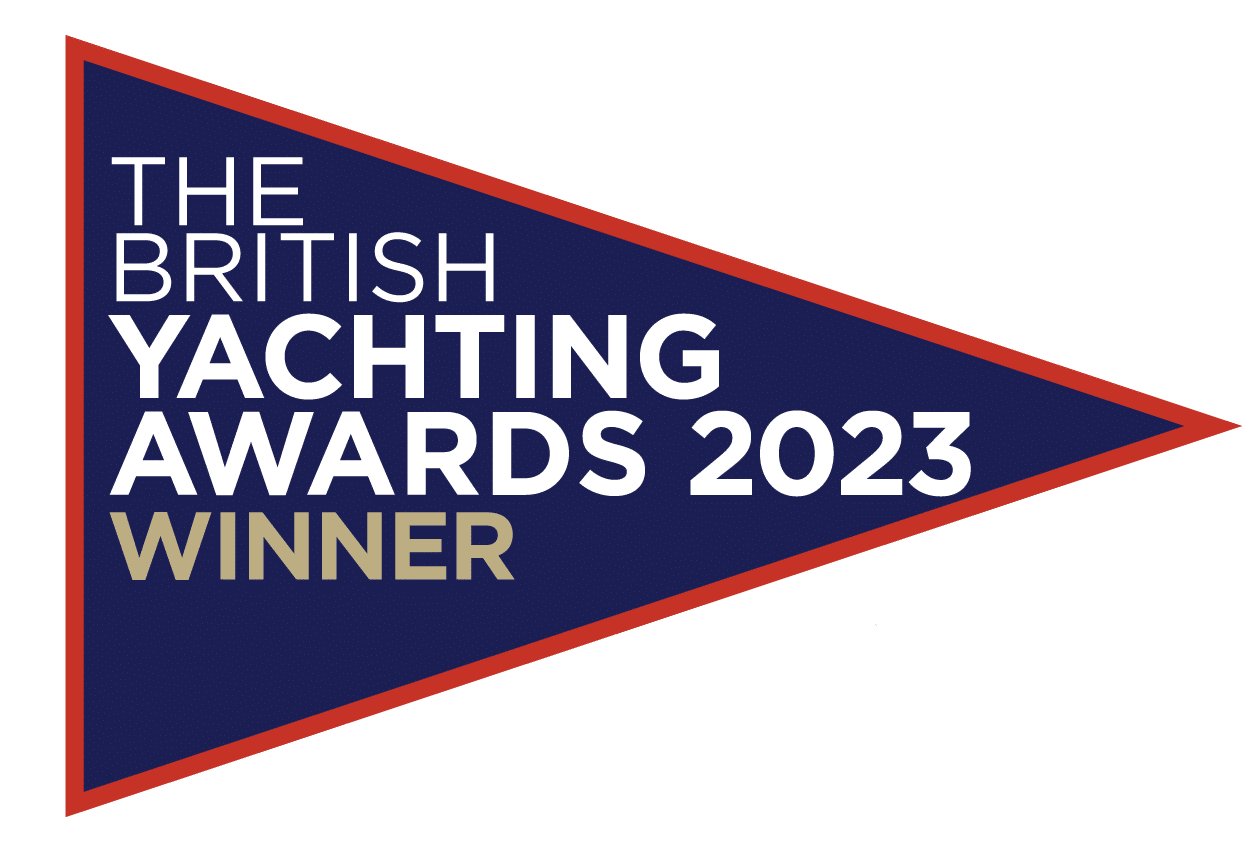
Our 52-foot catamaran, the best of two iconic models
Request information.
Seaworthy and smart for the ultimate cruising experience
The avant-garde, new benchmark for blue-water cruising
The Outremer 52 has been designed based on the observation of the owners’ needs and uses. While performance and safety have always been the basis for the design of Outremer blue water catamarans, simplicity of navigation and quality of life on board are the two essential components that completes the specifications of Outremer teams. Surrounded by the best naval architects (VPLP), and great names in French design (Patrick Le Quément, Darnet Design, Saguez & Partners), the Outremer shipyard has engineered a smart and seaworthy 52-foot catamaran for the ultimate bluewater cruising experience.
Download the brochure

Outstanding visibility
Since the performance of a catamaran is largely determined by its weight, ingenuity was required to build the structure of this new model. An innovative technology developed by the Gunboat shipyard (also a member of the Grand Large Yachting Group), has made it possible to reduce the weight of the structure, while maintaining a high level of resistance. This has made it possible to increase the glass surfaces and openings in the boat that allows crews the reassuring benefit from increased visibility during navigation, regardless of their position in the saloon or cockpit.
Whether for ocean crossing, sailing around the world, or along the coast, this 52-foot catamaran will make sailors and their families feel both safe and comfortable on their liveaboard boat.
Improved user experience
This new model has been designed to make life on board easier in all circumstances. While it benefits from the upgrades of the Outremer 55, such as the different helm positions, the front view from the saloon and the helm bench adapted for two people, the Outremer 52 goes even further. The architectural communication between the interior and exterior living spaces allows for better watchkeeping on board: at the bar area in the cockpit, for example, it is possible to have a meal while continuing to keep watch ahead. At night, watches can be taken from the saloon’s bench which was designed in the direction of the navigation.
Inviting space
Everything has been carefully thought out to allow the enjoyment of every aspect of life on board. The Outremer 52 is a blue water cruising catamaran filled with natural light, offering living spaces adapted to long voyages. The common living spaces have been designed to facilitate circulation on board, to extend the feeling of wide-open spaces and to allow for festive moments with family or friends. The full opening of the bay window allows easy circulation and creates a convivial space between the cockpit and the saloon. The kitchen’s work surface is open to the interior and exterior spaces of the catamaran, and will undoubtedly be a privileged place to meet at any time of the day.
Customized and modular interior designs
To meet the very different needs of each catamaran owner, Outremer has designed a modular space called My Free Space. Located in the port forward cabin, this space can cover five different uses:
- a double cabin
- a convertible office with bunk beds
- a modular cabin, with an office convertible into a workshop, a folding bench and numerous storage spaces
- a dressing room
- a child’s cabin
| Architects | VPLP Design |
|---|---|
| Design consultant | Patrick Le Quément |
| Interior designer | Darnet Design |
| Length | 51.6 ft |
| Beam | 25.9 ft |
| Draught | 3.5 ft/ 6.7 ft |
| Air draught (without antenna) | 75.5 ft |
| Displacement | 12,5 t / 15,7 t |
| Sail plan - Mainsail - Genoa - Selftacking jib - Gennaker (optional) - Spinnaker (optional) | |
| CE approval | 8/26 p |
| Engines | 2 x 50 HP |
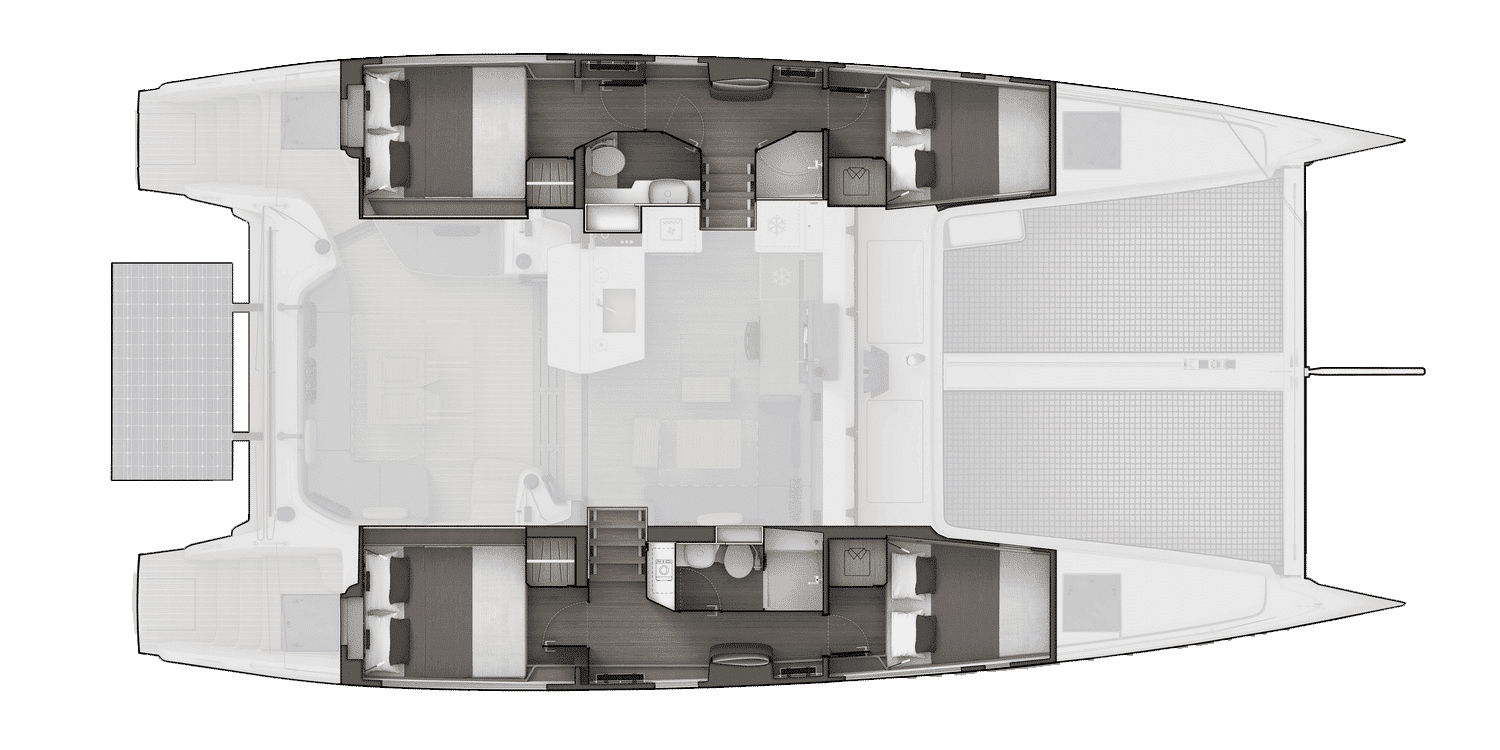
Beyond building your boat, Outremer brings your dreams to life by being by your side at every stage of your project. To always better support you, we have created Outremer Services. This structure, integrated within Grand Large Services is able to meet all your needs, from the start of your project to the resale of your catamaran.
Seminars on the theme of blue-water cruising, training on land and at sea, charter, concierge services, refit, a network of approved partners around the world, OCM ™ e-maintenance and lastly brokerage. We offer complete and personalized support according to best fit your needs.
Impatient, not sure you can invest in a new catamaran or simply curious? See our latest second-hand boats on offer. Please note that the demand is high, don’t wait to contact us.
Charter an Outremer
SHORT TERM CHARTER WITH SKIPPER
From the legendary Outremer 45 to the acclaimed Outremer 55, not to forget the 51 and the 4X, you will find a wide range of Outremer catamarans to charter, depending on your model of interest.
Yachting Monthly
- Digital edition

Monohull or multihull: which is best for blue water?
- Chris Beeson
- March 29, 2016
As former editor of Yachting World, David Glenn has plenty of experience of both monohull and multihull cruising. Here he weighs up the pros and cons

One hull, or two? Your choice will define your life afloat Credit: David Glenn
Through the binoculars I could see masts off Basil’s Bar on Mustique. Their lack of movement suggested a fine anchorage, sheltered from the tradewind-driven swell that builds up in the channel between Mustique and Bequia. It soon became apparent that most belonged to cats, immune from the rolling monohulls like ours would endure if we were to stop in this otherwise enticing bay.
More anchorages in a multi

Cats galore off the Soggy Dollar Bar, Jost van Dyke: too shallow for a fixed keel monohull of similar size
Stability is one of the truly great advantages of a cruising multihull. Not just at sea where the tiresome business of heeling is something that simply doesn’t – or shouldn’t – happen to any great extent, but at anchor too. It dramatically widens one’s choice of anchorages to include those affected by swell – not uncommon in the Caribbean, for instance, where a subtle change in wind direction can make a previously flat calm anchorage unbearable in a monohull. Its comparatively shoal draught widens the choice still further.
I grew up with monohulls, own one, and frankly wouldn’t consider a multihull for the sort of sailing I do. In northern European waters, marina berthing is a regular necessity and completely safe open anchorages are few and far between.

No rolling or heeling, 360° views and one-level living, as here on a Lagoon 52, appeal to many
But if I were to undertake some serious blue water cruising and I wanted family and friends genuinely to enjoy being afloat, particularly those less experienced, a multihull would have to be a consideration. I would have to put aside the question of aesthetics – let’s face it, they’re ugly beasts – and forego that unique and satisfying sensation of a yacht sailing well, because to date I have not experienced it in a cruising multihull. And that’s quite a sacrifice.
More space in a multi
My attitude changed after chartering catamarans in the Caribbean and Mediterranean. The need to accommodate two families comprising largely of teenage children made the choice of a multihull a no-brainer. In a 46-footer we could accommodate a party of 10 in comfort and the paraphernalia demanded by youth, like surfboards, windsurfers, kites and snorkelling kit, without feeling jammed in.

One-level living makes a big difference when sailing as a famly
The cavernous berths in the ends of the hulls, the wide saloon-cum-galley with its panoramic view and the inside/outside lifestyle made possible by the juxtaposition of the big aft deck and the same level saloon, got the entire crew onside instantly.
As an outside living space, with a trampoline at one end and a massive aft deck at the other, there is simply no comparison with a monohull of the same length. So space, linked to stability, makes for an experience that everyone, even the timid and novices, will find hard not to enjoy.
No speed difference

A multihull, like this Moorings 46, has abundant stowage on deck and below, but filling it all will slow her down
Load-carrying ability is a double-edged sword. On the up side there is room for a big crew and its kit, much more fresh water tankage than a monohull, eliminating the need for an expensive, temperamental watermaker, and finding space for a generator should be easy.
On the down side the temptation to overload will probably cancel out any perceived performance advantage. Multihulls can be relatively quick in the right offwind conditions, but if they are heavily laden – as they will be for blue water cruising – there really is no significant speed advantage.

The Gunboat 66 Phaedo 1 piles on the speed, but for blue water cruisers, comfort and stowage is more important than pace
Some new designs such as Gunboat and Outremer have concentrated on performance, but most clients aren’t overly concerned about outright speed and are happy to trade performance for the considerable comfort offered by brands like Lagoon, Broadblue, the Fontaine Pajot stable, Leopard, Catana, Privilege and others.
Mono sails better

Monohulls, like this Amel 55, sail better upwind, and her ballast keel adds displacement, which means comfort when it’s rough. Multihulls can develop an unpleasant motion in a big sea
Upwind, most cruising multihulls won’t point like a monohull with a deeper keel, and when it gets lumpy and fresh, the motion can become distinctly unpleasant. You have to keep a particularly careful eye on sail area too, but more of that in a moment.
In 2011 I was involved in a test of three cruising catamarans and among my fellow judges was multihull design legend Nigel Irens. He pointed out that catamaran buyers have voted for accommodation (which means weight) over performance, so the dilemma of mixing the two has largely disappeared. With it went the spectre of capsize because, relative to their displacement and beam, the modern cruising catamaran is under-canvassed. But that doesn’t mean that sailors can simply set sail and go in any weather.
‘Speed limits’ on a multi

On a multihull, it’s more important to know when to reef. Set speed limits and stick to them
Also on the panel was Brian Thompson, the lone Brit on board the 130ft French trimaran Banque Populaire V that sailed around the world in under 46 days. He told me that the tell-tale signs for knowing when to reef are far more subtle on a multihull. Apart from instinct, Brian suggested monitoring boat speed closely and having a speed limit to trigger reefing. It is easy to overlook a building breeze when bowling along downwind in a multihull, which is going faster and faster. ‘Keep your boat speed within safe limits you should not get into too much trouble,’ he said.
People often ask about anchoring a multihull, which is important as a multihull will spend a lot of time at anchor. Squeezing into a marina can be nigh on impossible, and expensive if you can get in. An essential piece of kit, which should be standard with a new boat, is a bridle that runs from either hull and keeps the anchor cable on the centreline. In many ways this is easier than anchoring a monohull as it prevents the ground tackle from fouling the hulls.
If you do get alongside a marina pontoon you will soon discover another modern cruising multihull issue: excessive freeboard. It’s worth investing in a portable ladder for those marina moments. Of more concern is MOB recovery. There are bathing platforms on both hulls of most new boats, but it’s not the place to be if a yacht is pitching in a heavy sea. So considerable thought needs to be applied to retrieving an MOB if the worst happens.
The recent and dramatic increase in numbers of multihulls going blue water cruising is certainly testament to their appealing ‘lifestyle’ attributes, but one must bear in mind that they are not a fix for all liveaboard cruising challenges. It’s just a different way of doing things. The elements remain the same and can inflict just as much punishment for the unwary on a multihull as they can on a monohull.
Enjoyed reading this?
A subscription to Yachting Monthly magazine costs around 40% less than the cover price .
Print and digital editions are available through Magazines Direct – where you can also find the latest deals .
YM is packed with information to help you get the most from your time on the water.
- Take your seamanship to the next level with tips, advice and skills from our experts
- Impartial in-depth reviews of the latest yachts and equipment
- Cruising guides to help you reach those dream destinations
Follow us on Facebook , Twitter and Instagram.

The global authority in superyachting
- NEWSLETTERS
- Yachts Home
- The Superyacht Directory
- Yacht Reports
- Brokerage News
- The largest yachts in the world
- The Register
- Yacht Advice
- Yacht Design
- 12m to 24m yachts
- Monaco Yacht Show
- Builder Directory
- Designer Directory
- Interior Design Directory
- Naval Architect Directory
- Yachts for sale home
- Motor yachts
- Sailing yachts
- Explorer yachts
- Classic yachts
- Sale Broker Directory
- Charter Home
- Yachts for Charter
- Charter Destinations
- Charter Broker Directory
- Destinations Home
- Mediterranean
- South Pacific
- Rest of the World
- Boat Life Home
- Owners' Experiences
- Conservation and Philanthropy
- Interiors Suppliers
- Owners' Club
- Captains' Club
- BOAT Showcase
- Boat Presents
- Events Home
- World Superyacht Awards
- Superyacht Design Festival
- Design and Innovation Awards
- Young Designer of the Year Award
- Artistry and Craft Awards
- Explorer Yachts Summit
- Ocean Talks
- The Ocean Awards
- BOAT Connect
- Between the bays
- Golf Invitational
- BOATPro Home
- Superyacht Insight
- Global Order Book
- Premium Content
- Product Features
- Testimonials
- Pricing Plan
- Tenders & Equipment
Founded in 1991, Bluewater offers you more than 30 years of experience and is the only major yachting company with dedicated and experienced teams in the five main sectors of yachting: Yacht Brokerage, Yacht Charter, Yacht Management, Crew Training and Crew Solutions. We take pride in the fact that Bluewater is the only company able to sell, charter and manage yachts on which the crew were recruited and trained in-house.
An international team of experienced professionals, the Bluewater charter specialists have the expertise to ensure you find the right yacht for your charter, also providing tailor-made itineraries in all regions of the world. In addition, the charter management division works alongside owners to globally promote and charter their yachts, maximising potential revenue and minimising stress.
The Bluewater sales division offers unbiased, insightful and accurate advice into every facet of the yacht brokerage process. Whether you are buying or selling, a Bluewater client receives outstanding support and expertise, every step of the way.
Bluewater is based in in Monaco, Antibes, Palma, Zug, Moscow, Fort Lauderdale, Dubai and Hong Kong, ensuring that we can support you 24/7, wherever you are in the world.
Yachts for sale
Yachts for charter.
bluewater yacht master


IMAGES
COMMENTS
The ten best solo bluewater catamarans have unique designs, are about 40 feet (12.2m) long, boast an autopilot, all lines to the cockpit, and can provide a safe ocean passage with only one sailor on board. Popular short-handed bluewater cat models include the Manta 42, Dolphin 42, and the FP Belize 43. Whether you're looking to buy a brand ...
Outremer 51/55. When you think of multihulls designed for bluewater cruising, Outremer will likely be one of the first names that comes to mind. Its heritage lies in building catamarans that can ...
The best production blue water cruising catamarans are the Manta 42, the Lagoon 42, the Leopard 45, the Lagoon 450, and the Prout 45. These vessels have excellent living accommodations and great sea keeping abilities. In this article, we'll cover five of the best liveaboard cruising catamarans, along with what sets them apart from similar ...
The Ultimate Blue-water Cruising Catamaran. Outremer [utʀ əmε: ʀ] draws its origins from blue-water cruising and etymologically from the color Outremer, a deep shade of blue reminiscent of its native coast, the Mediterranean Sea. Sailing catamaran manufacturer, Outremer, has built over the past 37 years, catamaran sailboats of industry ...
But with its lightweight design, easy handling, and shallow draft of 1.8 feet, it is a perfect first step into catamaran ownership. Blue Water Catamarans Are a Fantastic Budget Option. Remember: When buying a bluewater cruising yacht for less than $100,000, compromise is inevitable.
Bluewater catamarans are generally larger than boats made for coastal sailing. On average, these vessels come in sizes between 30 - 70 ft, offering cargo and passenger space for a few dozen people or more. They feature carbon fiber or fiberglass construction and come in different sizes for various activities.
Here are our picks for the five best bluewater cruising powerboats of 2022. SILENT 62 3-DECK (Closed) Above: A 2022 Silent 62 triple deck catamaran yacht for sale on YachtWorld by Silent Yachts. Photo by Silent Yachts. This beautiful trans-ocean yacht is the ultimate in both luxury and design.
These bluewater cruisers offer the perfect combination of speed and performance for proper bluewater cruising ability ... the best new performance bluewater catamarans on the market 2018. Toby ...
This is commissioning, and it is the last stage of the build. Test the boat as rigorously as you can before you leave the proximity of the yard. Complete a couple of substantial offshore passages ...
The Longreach Bluewater is a brilliant balance between the comforts required for full time live aboard cruising, with efficiency in hull design for low fuel consumption and long range exploration. Reach further, stay longer. ... Thailand on board their brand new Longreach 1900 Bluewater power catamaran! ...
Privilege Catamarans America is the exclusive dealer for Privilège sailing and power catamarans in the USA, Canada and the Caribbean. ... semi-custom blue water catamarans. PRIVILèGE 510. PRIVILèGE 580. PRIVILèGE 650. PRIVILèGE 750. privilege catamarans. Privilège Signature 510. Privilège Signature 580.
Blue water in sailing means deep water, and bluewater cruising is a type of ocean cruising and yachting. Sailors who embark on long-range, oceangoing travel are often referred to as bluewater cruisers, and their vessels as bluewater sailing vessels, or bluewater cruisers. "Heading over the horizon" is a common phrase in the sailing world ...
The Outremer 52 is a blue water cruising catamaran filled with natural light, offering living spaces adapted to long voyages. The common living spaces have been designed to facilitate circulation on board, to extend the feeling of wide-open spaces and to allow for festive moments with family or friends. The full opening of the bay window allows ...
Multihulls can be relatively quick in the right offwind conditions, but if they are heavily laden - as they will be for blue water cruising - there really is no significant speed advantage. The Gunboat 66 Phaedo 1 piles on the speed, but for blue water cruisers, comfort and stowage is more important than pace.
About Discovery Bluewater 50 - "Binti" The Discovery 50 Catamaran has a prestigious pedigree. Sleek in appearance, responsive to handle and fast to sail she delivers the same exceptional construction and ocean cruising capabilities. This stunning yacht is a sumptuous home afloat, providing world-class cruising on the level.
The blue water capable ZEN50 lightweight racing carbon hulls are combined with a huge solar roof for an unrivaled solar power vs. displacement ratio above 1:1 (18 kW / 17 tonnes), making this yacht completely energy self-sufficient. A revolutionary, fully automated, wingsail - by Ayro© - can be added as a range and speed extender.
Bluewater; Discovery Catamaran Bluewater boats for sale. Save Search. Clear Filter Make / Model: Discovery - Bluewater Category: Sail - Catamaran. Location. By Radius. By Country. country-all. All Countries. Country-IT. Italy. All. All 25 miles 50 miles 100 miles 200 miles 300 miles 500 miles 1000 miles 2000 miles 5000 miles. from your location.
Bluewater. Founded in 1991, Bluewater offers you more than 30 years of experience and is the only major yachting company with dedicated and experienced teams in the five main sectors of yachting: Yacht Brokerage, Yacht Charter, Yacht Management, Crew Training and Crew Solutions. We take pride in the fact that Bluewater is the only company able ...
Caribbean Sailing School & RYA Training Centre. RYA Instructors; Sailing Yacht; Grenada and the Grenadines; Testimonials; RYA Start Yachting; RYA Competent Crew; RYA Day Skipper;
Since 2002, the yachting center has been a crown jewel for the Bluewater network, offering unparalleled hospitality and service for all our guests and visitors. Amenities include:
1997 Bluewater Yachts 680 Custom Series. US$250,000. ↓ Price Drop. Knot 10 Yacht Sales | Coltons Point, Maryland. Request Info; Sponsored Boats | related to your search. 2024 Excel 1651 F4 Shallow Water. US$23,999. Performance East Inc | Goldsboro, North Carolina. 2012 Custom Carolina 26cc.
Bluewater RUS Luxury Yachts, Moscow, Russia. 261 likes · 1 talking about this. Компания предоставляет услуги по аренде и продаже яхт по всему миру.
Bluewater Yachts for sale on YachtWorld are listed for a range of prices from $65,000 on the relatively lower-priced models, with costs up to $250,000 for the most extravagant model yachts. What Bluewater Yachts model is the best? Some of the most popular Bluewater Yachts models now listed include: 51 Coastal Cruiser, 41, 5200, 680 Custom ...